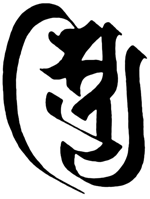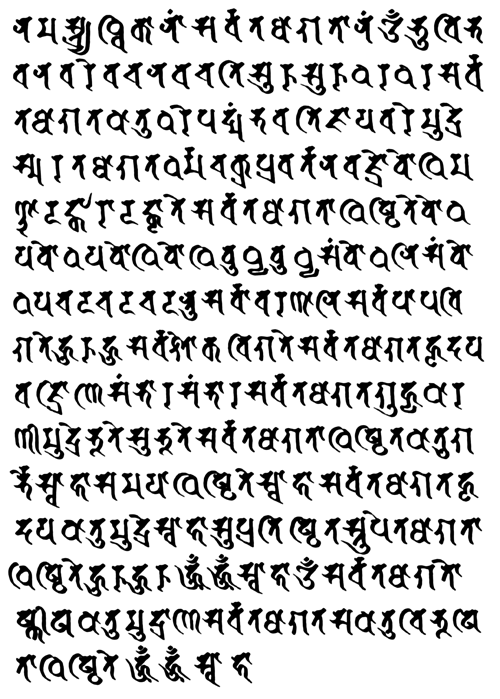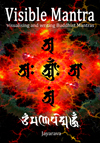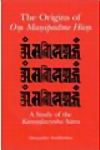
Seed-syllable
stryi
The Karaṇḍamudrā dhāraṇī (Japanese Hōkyōin darani 宝篋印陀羅尼) is an important litugical text in Japan. The dhāraṇī comes at the end of:
一切如來心祕密全身舍利寶篋印陀羅尼經 (Taisho T19 no.1022a).
In Sanskrit the title would be:
 Sarvatathāgatādhiṣṭhānahṛdayaguhyadhātukaraṇḍamudrā Dhāraṇī Sūtra
Sarvatathāgatādhiṣṭhānahṛdayaguhyadhātukaraṇḍamudrā Dhāraṇī Sūtra
सर्वतथागताधिष्ठानहृदयगुह्यधातुकरण्डमुद्रा धारणी सूत्र
i.e. The sutra of the spell (dhāraṇī) which is the symbol (mudrā) of the casket (karaṇḍa) of the secret heart element (hṛdaya-guhya-dhātu) which is the basis (adhiṣṭhāna) of all those in that state (tathāgata). A better English translation would be The sūtra of the spell symbolising the casket containing the mysterious essence of the basis for all the Awakened.
The Karaṇḍamudrā dhāraṇī is associated with the complex seed-syllable (bījākṣara) stryi (see left). This appears to derive from the first few syllables of the dhāraṇī:
नमस्त्र्यध्विकानां सर्वतथागतानां
namastryadhvikānāṃ sarvatathāgatānāṃ
homage to all the Tathāgatas of the three times.
Namastryadhvikānāṃ breaks down into namas tryadhvikānāṃ. Namaḥ means homage, and Sanskrit sandhi rules require swapping ḥ for s when followed by t.
Tradhvikānāṃ = tri + adhvan + -ika + -nāṃ; tri (three) adhvan (times) -ika (belonging to) -nāṃ (genitive plural case ending). When followed by a vowel, i becomes y, so tri > try. Adhvan + ika > adhvika is a taddhita compound, although we would usually expect the initial vowel of the base to lengthen (ādhvika) in cases like this. The grammar in dhāraṇī's is often not what you might expect from Classical Sanskrit - most likely because they were not composed in Classical Sanskrit but one of the vernaculars.
Now broken into syllables for writing in Siddhaṃ:

na ma strya dhvi kā nāṃ
As the first syllable following the namaḥ (homage) strya comes, by metonymy, to stand for the whole dhāraṇī.
In the Chinese Tripiṭaka in the Taisho edition. the Siddhaṃ script version of the dhāraṇī reads: na maḥ stryi dhvi ka nāṃ sa rva ta thā ga ta nāṃ... Someone has made a pdf of 1022a from the CBETA reader software. It's not clear why the syllable became styri with an i, but I suspect that it was how the mantra was heard, by the translator - running the syllables together in speech it does sound rather like namas stryi adhvikanāṃ.
Karaṇḍamudrā means 'seal (mudrā) of the casket (karaṇḍa)' - a karaṇḍa was used for keeping relics (see Studholme, A. The Origins of Oṃ Maṇipadme Hūṃ : a Study of the Kāraṇḍavyūha Sūtra. SUNY Press. p.10). In Japan the dhāraṇī is associated with the hōkyōintō (宝篋印塔) style of stūpa on which one sees the syllable stryi carved.
Karaṇḍamudrā Dhāraṇī

Transliteration
namastryadhvikānāṃ sarvatathāgatānāṃ | oṃ bhuvibhavanavare vacanavacati | suru suru dhara dhara | sarvatathāgatadhātu dhare padmaṃ bhavati | jayavare mudre | smaratathāgatadharmacakrapravartana vajre bodhimaṇḍālaṅkārālaṅkṛte | sarvatathāgatādhiṣṭhite | bodhaya bodhaya bodhi bodhi budhya budhya | saṃbodhani saṃbodhaya | cala cala calantu sarvāvaraṇāni | sarvapāpavigate | huru huru sarvaśokavigate | sarvatathāgatahṛdayavajriṇi | saṃbhāra saṃbhāra | sarvatathāgataguhyadhāraṇī mudre | bhūte subhūte | sarvatathāgatādhiṣṭhitadhātu garbhe svāhā | samayādhiṣṭhite svāhā | sarvatathāgatahṛdayadhātu mudre svāhā | supratiṣṭhitastūpe tathāgatādhiṣṭhite huru huru hūṃ hūṃ svāhā | oṃ sarvatathāgatoṣṇīṣadhātu mudrāṇi sarvatathāgatasadhātu vibhūṣitādhiṣṭhite hūṃ hūṃ svāhā ||
Devanāgarī
नमस्त्र्यध्विकानां सर्वतथागतानां । ओं भुविभवनवरे वचनवचति । सुरु सुरु धर धर । सर्वतथागतधातु धरे पद्मं भवति । जयवरे मुद्रे । स्मरतथागतधर्मचक्रप्रवर्तन वज्रे बोधिमण्डालङ्कारालङ्कृते । सर्वतथागताधिष्ठिते । बोधय बोधय बोधि बोधि बुध्य बुध्य । संबोधनि संबोधय । चल चल चलन्तु सर्वावरणानि । सर्वपापविगते । हुरु हुरु सर्वशोकविगते । सर्वतथागतहृदयवज्रिणि । संभार संभार । सर्वतथागतगुह्यधारणी मुद्रे । भूते सुभूते । सर्वतथागताधिष्ठितधातु गर्भे स्वाहा । समयाधिष्ठिते स्वाहा । सर्वतथागतहृदयधातु मुद्रे स्वाहा । सुप्रतिष्ठितस्तूपे तथागताधिष्ठिते हुरु हुरु हूं हूं स्वाहा । ओं सर्वतथागतोष्णीषधातु मुद्राणि सर्वतथागतसधातु विभूषिताधिष्ठिते हूं हूं स्वाहा ॥
Note I've consulted several sources for this and found that most versions break sandhi to facilitate reading and/or chanting. I've reconstructed the Sanskrit with sandhi as best I can. There are a number of problems with the Sanskrit in the Taisho version of the text.
Other bījas: a | āḥ | dhīḥ | hūṃ | hrīḥ | maiṃ | oṃ | tāṃ | traṃ | phaṭ | svāhā |



